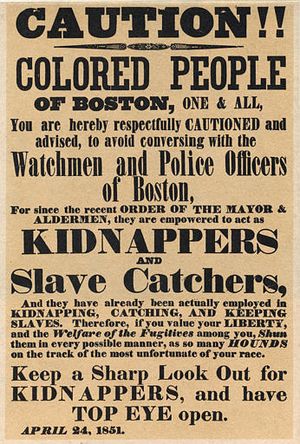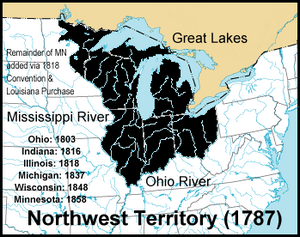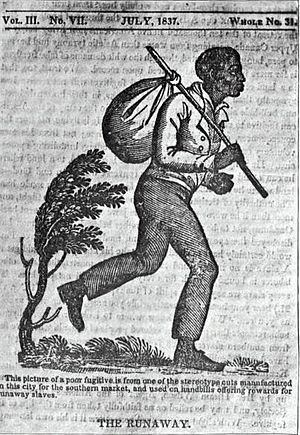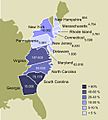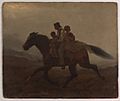Fugitive slave laws facts for kids
The Fugitive Slave Acts were two important laws passed by the U.S. government. These laws were about enslaved people who had escaped. The first law was passed in 1793, and the second in 1850.
These laws made it a federal responsibility to catch escaped enslaved people. This meant the U.S. government had to help find them. The laws were created to protect the rights of slave owners in the Southern states. They forced all states and areas to help capture and return anyone who had escaped slavery.
Many people in the Northern states strongly disliked these laws. They caused a lot of anger and disagreement. This anger was a big reason for the American Civil War that started later.
Contents
Understanding Slavery in America
Slavery in America began in 1619. This was when the first enslaved Africans arrived in the English colony of Jamestown. Colonists bought these 20 Africans. At first, they were treated like indentured servants. This meant they worked for a set time to pay off a debt.
Soon, it became common to hold people as slaves for their entire lives. During the 1600s and 1700s, enslaved people worked on farms. They grew crops like tobacco and food. In 1793, the cotton gin was invented. This machine made it much easier to process cotton. Cotton then became the most important crop in the South. Slavery became a huge part of the Southern economy.
The issue of slavery caused problems for the United States from its very beginning. The people who wrote the U.S. Constitution used unclear language about slavery. They did not even use the words "slave" or "slavery." It was hard to create a democracy that promised freedom to its citizens while keeping many people enslaved.
Up until the 1860s, enslaved people were treated as personal property. They had no legal rights. The U.S. Supreme Court decided in 1857 that enslaved people were not citizens. This ruling was called Dred Scott v. Sandford. However, in 1868, the Fourteenth Amendment changed this. It said that all people born in the U.S. were citizens.
Early Laws About Slavery
Northwest Ordinance of 1787
The Northwest Ordinance was a law passed in 1787. This was before the U.S. Constitution was written. It created the Northwest Territory, which was the first organized territory of the United States. This territory was made up of lands west of the Appalachian Mountains. It was south of British North America and the Great Lakes. It was north of the Ohio River.
The Northwest Ordinance said that slavery was not allowed in this new territory. However, it also said that any enslaved person who escaped into the territory had to be returned to their owners. It did not stop slavery in any new states that might be formed from the territory. People from the South thought that new settlers would vote to allow slavery later. But none of the states formed from the Northwest Territory ended up allowing slavery.
U.S. Constitution of 1789
When the U.S. Constitution replaced the Articles of Confederation in 1789, it included the Fugitive Slave Clause. This clause is in Article Four, Section 2. It says:
No Person held to Service or Labour in one State, under the Laws thereof, escaping into another, shall, in Consequence of any Law or Regulation therein, be discharged from such Service or Labour, but shall be delivered up on Claim of the Party to whom such Service or Labour may be due.
This meant that if an enslaved person escaped to another state, they could not be set free. They had to be returned to their owner.
The Fugitive Slave Acts
Fugitive Slave Act of 1793
The U.S. Constitution said that owners could reclaim escaped enslaved people. But it did not explain how to do it. The Fugitive Slave Act of 1793 fixed this. It gave the legal steps for arresting runaway slaves.
This law allowed any local official, like a judge, to rule on an arrest. The person hunting the escaped slave only had to say that the captured person was a runaway. No proof was needed, and there was no trial. The law also added a $500 fine for anyone who helped an escaped enslaved person. This law was passed because more people in the North wanted to end slavery. It was also a response to the Underground Railroad, which helped enslaved people escape.
Fugitive Slave Act of 1850
The Fugitive Slave Act of 1850 was a very controversial part of the Compromise of 1850. This new law added even tougher rules. It fined officials $1,000 if they did not arrest suspected runaway slaves. Any law enforcement officer had to arrest someone if they were suspected of being a runaway. All that was needed was someone's sworn statement of ownership.
Just like before, there was no trial. The suspected person could not speak to defend themselves. Anyone who gave food or shelter to a suspected runaway could face six months in prison and a $1,000 fine. An officer who caught a runaway slave would get a bonus. The 1850 law also created special commissioners. These officials decided if a person was to be returned to slavery. They received $10 if they sent the person back to slavery, but only $5 if they freed them. This was like a legal form of bribery. This system caused many free black people to be wrongly sent into slavery.
Impact of the Slave Laws
The 1850 Fugitive Slave Law made many people in the Northern states very angry. It convinced thousands of Northerners that slavery should not be allowed in new territories. Eight Northern states passed "personal liberty" laws. These laws tried to stop officials from helping to return escaped slaves. Southerners saw these laws as illegal attempts to prevent their slaves from being returned.
In the North, free black communities helped escaped slaves. They gave them safe places to hide from the hired kidnappers. After the 1850 law, about 15,000 free black people moved to Canada, the Caribbean, or Africa. Sadly, thousands of others, including free black people, were not so lucky. They were sent South into slavery.
In 1851, a fight broke out between people who wanted to end slavery and slave catchers in Christiana, Pennsylvania. In Wisconsin, an escaped slave named Joshua Glover was freed from jail by force. In Boston, a large crowd tried to free an escaped slave named Anthony Burns. It took many state troopers to stop them. These events made the Southern states believe that the North would not follow the slave laws.
Images for kids
-
A Ride for Liberty—The Fugitive Slaves (c. 1862) by Eastman Johnson Brooklyn Museum


